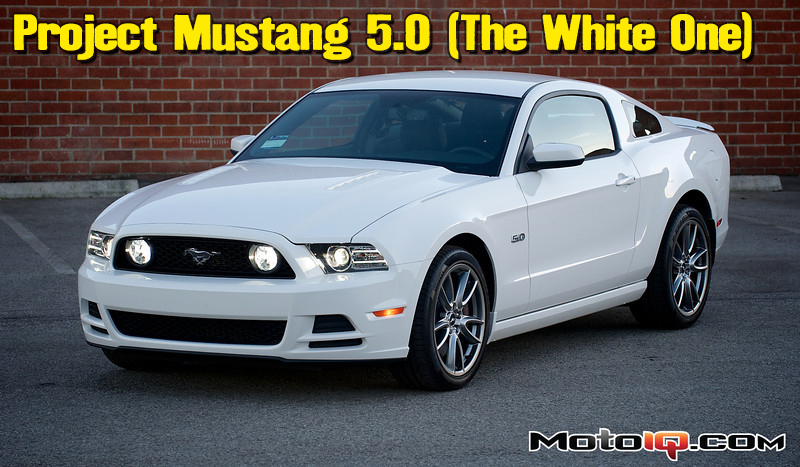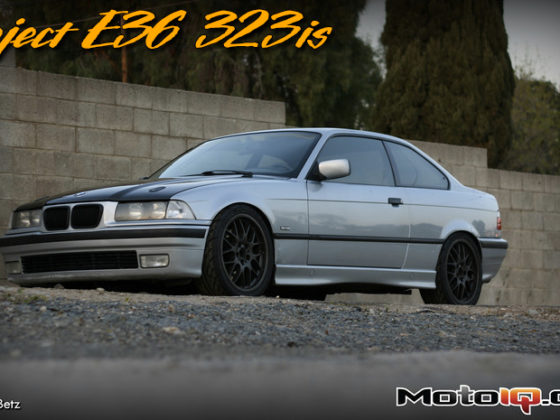,

Acceleration was great. The combination of the wide power band from the variable cam timing and 5.0 liters, plus the short 3.73 factory option final drive ratio made for speed in the straights. The “Coyote” 5.0 DOHC V8 is as exotic and technologically advanced as most any import motor. Strong forged rotating assembly, light weight aluminum block, heads that breathe well at high RPM, and more variable cam timing adjustment on both the intake and exhaust cams then the current BMW M3 V8. This performance will only improve with the high level of power parts options whether you choose to remain naturally aspirated or go forced induction.
 Coming on to the front straight exiting the final right hand “skid pad” turn, Project 5.0 had a tendency to produce power-on oversteer. Careful application of the throttle kept the rear for the most part in line, but there is more longitudinal grip to be desired which can be had with a properly wide wheel/tire combo and suspension upgrades.
Coming on to the front straight exiting the final right hand “skid pad” turn, Project 5.0 had a tendency to produce power-on oversteer. Careful application of the throttle kept the rear for the most part in line, but there is more longitudinal grip to be desired which can be had with a properly wide wheel/tire combo and suspension upgrades.In general, suspension settings were soft. There were noticeable amounts of body roll under lateral load, as well as an excessive amount of dive under braking. Squat under acceleration was significant but rear end traction was still solid. Lack of sufficient low speed rebound damping was obvious while navigating through the high speed chicane's uneven surface. Rear wheel hop reared its ugly head during some of the course's corner exits.
The rigidity of the S197 chassis, despite now being in its 8th year of production, is an obvious improvement over the previous SN95 gen Mustangs. Every time I drive a S197 Mustang on track, it feels like Ford knew this car would get time and be judged on a road course rather then just on a drag strip. The prowess of the current Mustang platform and its potential on road courses is deeply apparent from its success in series like Continental Grand Am, and Pirelli World Challenge.
 Project 5.0's body roll in stock trim is more then apparent in the corners even with the somewhat narrow tires offered from the factory. Adequately wide tires and wheels would provide more grip but at the same time would expose the stock suspension's short comings further still while on track. A more performance oriented chassis tune will pay large dividends on our powerful pony.
Project 5.0's body roll in stock trim is more then apparent in the corners even with the somewhat narrow tires offered from the factory. Adequately wide tires and wheels would provide more grip but at the same time would expose the stock suspension's short comings further still while on track. A more performance oriented chassis tune will pay large dividends on our powerful pony.After some tire pressure changes and testing from the first run session, overall grip was not terrible and we were not beating up the outside edges excessively despite the lack of static negative camber angles ideal for track use. The compound of the Pirelli P Zero's is plenty sticky for a street tire. But the size, at 255mm wide all around, does not provide enough grip or heat capacity for the 3600+lbs/400+hp mustang after a few hot laps. With 100 degree ambient temperatures and even hotter surface temps, the front to rear grip balance would only stay sufficient for a couple of hot laps. By the 3rd hot lap the car had trouble getting corner exit traction and by the 4th lap, the front would understeer significantly.
Brake performance was surprisingly good. Despite the stock brake pad compound's lack of huge amounts of bite, the big 'Stang would come to a halt at a decent rate. Part of this can most likely be attributed to the tire's grip and optional sport package Brembo calipers. A proper pad compound change and stainless line upgrades would help improve braking performance and feel. Still, considering the weight and power of the car, it was an impressive performance for a stock system.
Steering feel is well weighted for a stock car, and surprisingly communicative considering the full electronic power steering system. Throttle response is exactly how a NA car should be, – direct and easy to modulate. Shift feel was confidence inspiring, but the driveline and shift lever seemed to have excessive movement under load, sometimes making for a gear selection to hit the gate between gears. Stock seat support under cornering is subpar, especially for my small frame build.
Engine cooling didn't seem to have issues during the day. But consecutive hot laps were kept to a minimum due to the hot ambient temps, narrow tires and the stock braking system. The size of the radiator is decent. But the oil to water cooling donut may need to be replaced with an air to oil unit later down the road once the car's chassis tune allows for more consecutive laps.
The car's handling dynamics are predictable and the suspension geometry is fairly simple. The front end is a MacPherson strut assortment and the rear is a live axle which many shun as dated. but I feel it is easy to read when approaching the limit and in oversteer. With a long wheelbase, the car felt a bit sluggish around some of the tight turns at Streets of Willow. This was also apparent during rotation under trail braking. But at the same time, that wheelbase allowed the rear end break loose very progressively.
Thanks to K.R.O.P.S we had a solid amount of track time to collect data and get a baseline of the car's performance, both in terms of lap times and 0-60 using Qstarz LT-Q6000 data acquisition unit. If you have any inquiries about Qstarz products contact http://tony_chen@qstarz.com and to purchase the LT-Q6000 visit uglycases.com.




